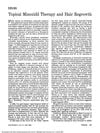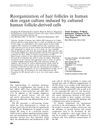TLDR EGF and FGF boost hair cell growth, hydrocortisone slows it, and minoxidil doesn't affect it.
This study examined the effects of epidermal growth factor, fibroblast growth factor, minoxidil, and hydrocortisone on the growth of human hair bulb papilla cells and root sheath fibroblasts cultured in vitro. The results showed that EGF and FGF increased proliferation of both cell types, while hydrocortisone slowed proliferation, and minoxidil had no effect. The study suggests that the dermal papilla can be considered a target tissue for agents influencing maintenance of hair growth.
106 citations
,
April 1986 in “British Journal of Dermatology” Dermal papilla cells from human hair follicles form unique structures and don't live as long as other skin cells in lab conditions.
 20 citations
,
February 1985 in “Archives of Dermatology”
20 citations
,
February 1985 in “Archives of Dermatology” Minoxidil helps hair regrowth, especially with more indeterminate hairs.
 72 citations
,
December 1983 in “Journal of Investigative Dermatology”
72 citations
,
December 1983 in “Journal of Investigative Dermatology” Minoxidil helps hair cells live longer and grow longer.
84 citations
,
February 1981 in “Journal of Endocrinology” Epidermal growth factor slows hair and body growth in mice.
4 citations
,
May 2022 in “International journal of molecular sciences” Heat-killed Enterococcus faecalis EF-2001 may promote hair growth and transition hair follicles to the growth phase.
January 2006 in “Chinese Journal of Dermatology” Mesenchymal cells are essential for hair follicle stem cell growth.
Some factors can either promote or inhibit hair growth.
 56 citations
,
July 2005 in “Experimental Dermatology”
56 citations
,
July 2005 in “Experimental Dermatology” Injected human hair follicle cells can create new, small hair follicles in skin cultures.
 94 citations
,
February 1994 in “The journal of investigative dermatology/Journal of investigative dermatology”
94 citations
,
February 1994 in “The journal of investigative dermatology/Journal of investigative dermatology” EGF makes hair follicles grow longer but stops hair production.
 58 citations
,
June 1987 in “Archives of Dermatological Research”
58 citations
,
June 1987 in “Archives of Dermatological Research” EGF and FGF boost hair cell growth, hydrocortisone slows it, and minoxidil doesn't affect it.
9 citations
,
March 1987 in “British Journal of Dermatology” EGF and FGF can boost hair growth by speeding up cell growth.
114 citations
,
September 1985 in “Journal of Investigative Dermatology”






